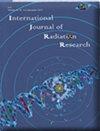Changing the entrance surface dose and image quality by applying an air mattress to the table commonly used in computed tomography
IF 0.4
4区 医学
Q4 RADIOLOGY, NUCLEAR MEDICINE & MEDICAL IMAGING
引用次数: 0
Abstract
Background : In this study, the changes in the entrance surface dose (ESD) and image quality were examined when an air mattress was used to reduce the X-ray scattering caused by treatment tables commonly used for computed tomography (CT). Materials and Methods : Dual-energy CT (DECT) was used, with the ESD of Alderson Radiation Therapy (ART) phantom measured by scanning with different X-ray tube voltages and X -ray tube currents for three scenarios: when no air mattress was employed, and when a 5 cm or 10 cm thick air mattress was employed. The statistical significance of the changes in ESD and image quality were based on the presence and thickness of the air mattress. Additionally, the variations of the X-ray tube voltage and current for different air mattress thicknesses were investigated using paired t-test . Results : For all X-ray tube voltages and currents, applying an air mattress significantly improved both the ESD and image quality, with the 5 cm air mattress improving both the ESD and image quality. Conclusion : The 5 cm air mattress produced no artifacts in the diagnostic images, and demonstrated a statistically significant reduction in patient ESD during DECT imaging.通过在计算机断层扫描中常用的桌子上应用气垫来改变入口表面剂量和图像质量
背景:在本研究中,研究了当使用气垫来减少计算机断层扫描(CT)常用治疗台引起的x射线散射时,入口表面剂量(ESD)和图像质量的变化。材料与方法:采用双能CT (DECT),在不使用气垫、使用5 cm或10 cm厚气垫三种情况下,通过不同X射线管电压和X射线管电流扫描测量Alderson Radiation Therapy (ART) phantom的ESD。静电放电和图像质量变化的统计学意义是基于气垫的存在和厚度。此外,采用配对t检验研究了不同气垫厚度下x射线管电压和电流的变化。结果:在所有x射线管电压和电流下,使用气垫均可显著改善ESD和图像质量,其中5cm气垫可同时改善ESD和图像质量。结论:5cm气垫在诊断图像中没有产生伪影,并且在DECT成像中显示患者ESD有统计学意义的降低。
本文章由计算机程序翻译,如有差异,请以英文原文为准。
求助全文
约1分钟内获得全文
求助全文
来源期刊

International Journal of Radiation Research
RADIOLOGY, NUCLEAR MEDICINE & MEDICAL IMAGING-
CiteScore
1.10
自引率
33.30%
发文量
42
期刊介绍:
International Journal of Radiation Research (IJRR) publishes original scientific research and clinical investigations related to radiation oncology, radiation biology, and Medical and health physics. The clinical studies submitted for publication include experimental studies of combined modality treatment, especially chemoradiotherapy approaches, and relevant innovations in hyperthermia, brachytherapy, high LET irradiation, nuclear medicine, dosimetry, tumor imaging, radiation treatment planning, radiosensitizers, and radioprotectors. All manuscripts must pass stringent peer-review and only papers that are rated of high scientific quality are accepted.
 求助内容:
求助内容: 应助结果提醒方式:
应助结果提醒方式:


